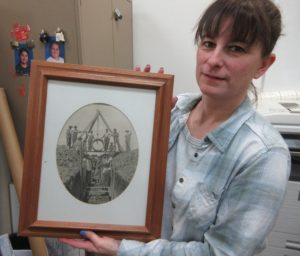~by Chuck Offenburger for the Greene County Historical Society

Most of us seldom think about it, but below the surface of the fertile farm ground of Greene County, there are nearly 3,000 miles of drainage tubes and pipes, “ranging from four inches to 48 inches in diameter,” says the county’s drainage clerk Michelle Fields. She thinks about that drainage system all the time.
Fields will speak about the 100-year history and impact of drainage and tiling when the Greene County Historical Society meets on Friday, April 6, at the United Methodist Church in Cooper.
The original tiles and pipes were buried between 1910 and 1919, most of it happening under the direction of S.J. Melson, then the Greene County engineer. Work crews dug most of the trenches by hand.
“I’ve got some figures on what the cost of that was back then, and how that compares to the cost of repairing or putting in new tiles today,” Fields said in an interview in her first-floor office at the courthouse in Jefferson.
Actually, whatever the cost, it’s been worth it – then and now.
The late James H. Andrew, who was officially recognized as the county’s “Mr. History” before his death in 2014, said in a 2012 interview that the installation of the tiling and draining of many of the county’s extensive native wetlands “was probably the most important event” in local history. Why? “Without that system, three-fourths of the land we’re farming today would still be wetlands,” he explained.
Fields has served 10 years as the county drainage clerk, a job that occupies about 30 to 40 percent of her work time. She is also the county government’s information technology manager and geographic information system coordinator.
How long did it take her to learn all she needed to know about the drainage system in the county?
“I’m still learning,” she said. “I didn’t know a lot about drainage when I got the job. I grew up near Springville in eastern Iowa, where there are no drainage districts. That’s because the last glaciers didn’t reach that area, so the lands is all hills and valleys, with natural drainage. Here, the last glacier covered most of what is Greene County today, flattening it out and leaving lots of marshes that would not drain on their own. Geologists refer to the big plain that was left as ‘the Des Moines Lobe,’ and they call this area a ‘prairie pothole region’.”
There are about 160 drainage districts in the county, ranging in size from about 250 acres up to 16,000 acres, with “the size being driven by how big the watersheds are that the district is covering,” she said. “The people who own that land are the owners of those drainage districts, but they’re administered by the members of the county board of supervisors, who serve as the trustees of the districts.”
The drainage districts have taxing authority to pay for tile repairs, and the landowners are assessed for the costs.
Of course, the pipes, equipment and technology used in drainage and tiling have changed drastically over the past century. Some of the original pipes put in the ground were actually made from wood. Soon, though, clay tiles came into use for pipes up to 12 inches. Pipes bigger than that were made from concrete. Today, the most common drainage tiles are made of tough plastic.
“There are single-wall plastic products that have perforations to let the water seep in from the ground,” Fields said. “And there are dual-wall plastic pipes, with the outside pipe having a kind of corrugated surface and the interior pipe being like a sleeve that is smooth, and they are not perforated. Those are used to move a lot of water from one point in the field to a larger drainage pipe at some distance away.”
Control mechanisms can even be placed inside the pipes to regulate the amount and volume of water being removed from an area, “so there is a precision ag element to drainage now,” she said.
Drainage tiles are buried deeper today, meaning they are less likely to be impacted by whatever is being done on the ground’s surface.
“But there will always be ‘blowouts,’ cracks and other problems,” she said. “And a common aggravation for farmers is that they’ll think there is a problem in about six feet of a tile that needs to be replaced, but somehow that seems to turn into a 20-foot-long problem.”
Fields plans to bring along some historic maps, photos and examples of the tile pipes for her presentation to the Historical Society.
A lunch at 12 noon in the church hall in Cooper is $8 for Historical Society members, $10 for non-members. The members should phone reservations to their community contacts by 3 pm on Wednesday, April 4. Others can RSVP for lunch by calling Nancy Hanaman, vice-president of the society, at 515-436-7684. The program at 1 pm in the church sanctuary is free.
